The accident investigator searching for the cause of the Columbia disaster said he was surprised by the force that foam tearing off of the shuttle’s fuel tank could cause to its wing. In a recent experiment, investigators fired a 760 gram chunk of foam at a fiberglass replica of the shuttle’s wing and tore open an important seal. Even more damage is expected when the next round of tests are performed with real shuttle wing parts, removed from Discovery, which are composed of reinforced carbon.
Expecting Another
Well, it appears that Chloe is going to be getting a brother or sister later this year. Yep, my wife’s pregnant for the second time, the due date is December 24th. Poor Katrina’s in the morning sickness/insomnia/exhaustion stage, but that should end wrap up in a few weeks we hope. It’s a lot harder to deal with this stuff when you’ve already got a kid. 🙂
We don’t have any names picked out, in fact, it’s kind of a touchy subject. Katrina’s got lots of ideas, and I’m Mr. Naysayer. I’m holding out for obscure but cool names which can’t be rhymed with anything. Anyway, if you’ve got some suggestions, pass them along.
Fraser Cain
Publisher
Universe Today
NASA Ready for Twin Rover Launch
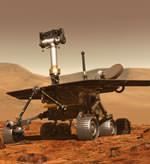
Image credit: NASA
The invasion of Mars continues. Next up: NASA’s Mars Explorer Rover-A which has been cleared to launch Sunday, June 8 at 1805 GMT (2:05pm EDT). Rover-A and its twin carry a suite of geological instruments to examine rocks and soil searching for evidence of past water on Mars. Scientists back on Earth will guide the rovers to various target rocks for closer examination. The second rover is due to launch June 25 and will aim towards a different landing site on the Red Planet.
NASA’s Mars Exploration Rover project kicks off by launching the first of two unique robotic geologists on June 8. The identical rolling rovers can see sharper images, explore farther and examine rocks better than anything that’s ever landed on Mars. The second rover mission, bound for a different site on Mars, will launch as soon as June 25.
“The instrumentation onboard these rovers, combined with their great mobility, will offer a totally new view of Mars, including a microscopic view inside rocks for the first time,” said Dr. Ed Weiler, associate administrator for space science at NASA Headquarters, Washington, D.C. However, missions to Mars have proven to be far more hazardous than missions to other planets. Historically, two out of three missions, from all countries that have tried to land on Mars, ended in failure. We have done everything we can to ensure our rovers have the best chance of success.”
The first Mars Exploration Rover will arrive at Mars on Jan. 4, 2004; the second on Jan. 25. Plans call for each to operate for at least three months.
These missions continue NASA’s quest to understand the role of water on Mars. “We will be using the rovers to find rocks and soils that could hold clues about wet environments of Mars’ past,” said Dr. Cathy Weitz, Mars Exploration Rover program scientist at NASA Headquarters. “We’ll analyze the clues to assess whether those environments may have been conducive to life.”
First, the rovers have to safely reach Mars. “The rovers will use innovations to aid in a safe landing, but risks remain,” said Peter Theisinger, Mars Exploration Rover project manager at NASA’s Jet Propulsion Laboratory, Pasadena, Calif.
The rovers will bounce to airbag-cushioned landings at sites offering a balance of favorable conditions for safe landings and interesting science. The designated site for the first mission is Gusev Crater. The second rover will go to a site called Meridiani Planum. “Gusev and Meridiani give us two different types of evidence about liquid water in Mars’ history,” said Dr. Joy Crisp, Mars Exploration Rover project scientist at JPL. “Gusev appears to have been a crater lake. The channel of an ancient riverbed indicates water flowed right into it. Meridiani has a large deposit of gray hematite, a mineral that usually forms in a wet environment.”
The rovers, working as robotic field geologists, will examine the sites for clues about what happened there. “The clues are in the rocks, but you can’t go to every rock, so you split the job into two pieces,” said Dr. Steve Squyres of Cornell University, Ithaca, N.Y., principal investigator for the package of science instruments on the rovers.
First, a panoramic camera at human-eye height, and a miniature thermal emission spectrometer with infrared vision help scientists identify the most interesting rocks. The rovers can watch for hazards and maneuver around them. Each six-wheeled robot has a deck of solar panels, about the size of a kitchen table, for power. The rover drives to the selected rock and extends an arm with tools on the end. Then, a microscopic imager, like a geologist’s hand lens, gives a close-up view of the rock’s texture. Two spectrometers identify the composition of the rock. The fourth tool substitutes for a geologist’s hammer. It exposes the fresh interior of a rock by scraping away the weathered surface layer.
Both rover missions will lift off from Cape Canaveral Air Force Station, Fla., on Delta II launch vehicles. Launch opportunities begin for the first mission at 2:06 p.m. (Eastern Daylight Time) June 8 and for the second mission at 12:38 a.m. June 25, and repeat twice daily for up to 21 days for each mission.
“We see the twin rovers as stepping stones for the rest of the decade and to a future decade of Mars exploration that will ultimately provide the knowledge necessary for human exploration,” said Orlando Figueroa, director of the Mars Exploration Program at NASA Headquarters.
Original Source: NASA News Release
Hubble Reveals the Pencil Nebula
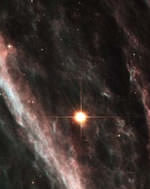
Image credit: Hubble
The Hubble Space Telescope has taken a new image of the Pencil Nebula, officially known as NGC 2736, which is part of the huge Vela supernova remnant located 815 light-years away. The nebula’s luminous appearance comes from dense gas regions which have been struck by the supernova’s shock wave and heated up. Astronomers estimate that the supernova went off 11,000 years ago; although, no historical records of the explosion have ever been found.
Remnants from a star that exploded thousands of years ago created a celestial abstract portrait, as captured in this NASA Hubble Space Telescope image of the Pencil Nebula.
Officially known as NGC 2736, the Pencil Nebula is part of the huge Vela supernova remnant, located in the southern constellation Vela. Discovered by Sir John Herschel in the 1840s, the nebula’s linear appearance triggered its popular name. The nebula’s shape suggests that it is part of the supernova shock wave that recently encountered a region of dense gas. It is this interaction that causes the nebula to glow, appearing like a rippled sheet.
In this snapshot, astronomers are looking along the edge of the undulating sheet of gas. This view shows large, wispy filamentary structures, smaller bright knots of gas, and patches of diffuse gas. The Hubble Heritage Team used the Advanced Camera for Surveys in October 2002 to observe the nebula. The region of the Pencil Nebula captured in this image is about three fourths of a light-year across. The Vela supernova remnant is 114 light-years (35 parsecs) across. The remnant is about 815 light-years (250 parsecs) away from our solar system.
The nebula’s luminous appearance comes from dense gas regions that have been struck by the supernova shock wave. As the shock wave travels through space [from right to left in the image], it rams into interstellar material. Initially the gas is heated to millions of degrees, but then subsequently cools down, emitting the optical light visible in the image.
The colors of the various regions in the nebula yield clues about this cooling process. Some regions are still so hot that the emission is dominated by ionized oxygen atoms, which glow blue in the picture. Other regions have cooled more and are seen emitting red in the image (cooler hydrogen atoms). In this situation, color shows the temperature of the gas. The nebula is visible in this image because it is glowing.
The supernova explosion left a spinning pulsar at the core of the Vela region. Based on the rate at which the pulsar is slowing down, astronomers estimate that the explosion may have occurred about 11,000 years ago. Although no historical records of the blast exist, the Vela supernova would have been 250 times brighter than Venus and would have been easily visible to southern observers in broad daylight. The age of the blast, if correct, would imply that the initial explosion pushed material from the star at nearly 22 million miles per hour. As the Vela supernova remnant expands, the speed of its moving filaments, such as the Pencil Nebula, decreases. The Pencil Nebula, for example, is moving at roughly 400,000 miles per hour.
Original Source: Hubble News Release
NASA Accepting More Astronaut Applications

Image credit: NASA
NASA announced last week that it is accepting new applications for astronaut candidates. Mission specialists require a bachelor’s degree and three years of appropriate experience, while pilot candidates also require a degree as well as 1,000+ hours piloting jet aircraft. After the applications are received, NASA will interview and evaluate the candidates for six months before announcing who will join the 2004 Astronaut Candidate Class.
NASA is accepting applications for mission specialist and pilot astronaut candidates to join the 2004 Astronaut Candidate Class.
To obtain an application package, call the Astronaut Selection Office in Houston at: 281/483-5907; or write to the Johnson Space Center, Astronaut Selection Office, Mail Code AHX, Houston, Texas 77058-3696. Application forms and additional information about the Astronaut Candidate Program are available electronically through the Astronaut Selection Office Web site at:
http://www.nasajobs.nasa.gov/astronauts/
Typically, successful applicants for the mission specialist astronaut positions have significant qualifications in engineering or science, while pilot candidates must have extensive experience flying high-performance jet aircraft.
Following an intensive six-month period of evaluation and interviews, the final selections will be announced in early 2004. Astronaut candidates will report to the Johnson Space Center during the summer of 2004 to begin the basic training program to prepare them for future spaceflight assignments.
The application deadline is July 1, 2003. Applications received after July 1 will not be considered for the 2004 class but will remain on file for subsequent selection cycles.
The Astronaut Candidate Class of 2004 also will include educator astronauts, teachers who will join NASA’s astronaut corps and encourage students to pursue studies in math and science. The Educator Astronaut Program (EAP) was announced in January, and applications closed April 30. More than 1,100 EAP applications have been processed. Information about the Educator Astronaut Program is available on the Internet at:
http://edspace.nasa.gov
For more information about NASA and the Human Space Flight Program on the Internet, visit:
http://www.nasa.gov
Original Source: NASA News Release
Jupiter Gets Even More Satellites
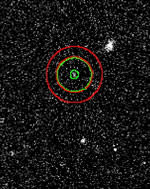
Image credit: UBC
A team of Canadian astronomers have discovered even more new satellites for Jupiter, giving the giant planet a total of 61 moons – 21 were discovered just this year. These new satellites are harder to detect because they’re only 1-5 kilometres across and have wide, irregular orbits around Jupiter. The team took a mosaic of images around the entire sky of Jupiter, and then used a computer to search for points of light that had the motion of a Jovian moon.
They were small and hard to find, but with the help of some new telescopic equipment and cameras, UBC professor Brett Gladman, UBC postdoctoral researcher Lynne Allen, and Dr. J.J. Kavelaars of the National Research Council of Canada have discovered nine previously unknown moons of Jupiter. So far this year, 21 new Jupiter moons have been identified.
The discovery of the distant satellites, announced today at the annual meeting of the Canadian Astronomical Society, boosts the number of known moons on Jupiter to 61 — more moons than any other planet in the solar system.
“The discovery of these small satellites is going to help us understand how Jupiter and the other giant planets formed,” said Gladman, a Canada Research Chair in Planetary Astronomy.
The new satellites were a challenge to detect because most are only about 1-5 kilometers in size. The feeble amounts of light they reflect back to earth must compete against the glare of brilliant Jupiter. Their small size and distance from the Sun prevent the satellites from shining any brighter than 24th magnitude, about 100 million times fainter than can be seen with the unaided eye. To locate these new moons, Gladman’s team used the new Megaprime mosaic of CCD cameras at the 3.6m Canada-France-Hawaii telescope on Mauna Kea, Hawaii.
The mosaic camera enabled the team to take three images of the entire sky around Jupiter. They used computer algorithms to search the images for the faint points of light moving across the sky as moons should.
Because moons can sometimes appear in front of distant stars or lost in the light scattered from the planet, to find them requires painstakingly repeating the search several times. The team undertook the task between February and April 2003.
International members of the jovian search team include Cornell University astronomers Phil Nicholson, Joseph A. Burns, and Valerio Carruba, Jean-Marc Petit of the Observatoire de Besancon, and Brian Marsden and Matthew Holman of the Harvard-Smithsonian Center for Astrophysics.
Original Source: UBC News Release
New Station Modules Arrive in Florida
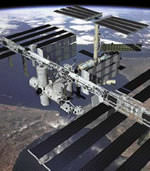
Image credit: NASA
Two major components of the International Space Station arrived at NASA’s Kennedy Space Center in Florida this week. Node 2, built by the European Space Agency, will increase the station’s living and work space, while the Japanese Experiment Module (JEM) will enhance its research capabilities. NASA engineers will perform integration tests over the course of the summer and then the modules will be moved to the KSC Space Station Processing Facility for a future launch on the space shuttle.
After traveling thousands of miles, two major components of the International Space Station completed the first leg of a journey that will eventually end 240 miles above the Earth. NASA’s Node 2, built for the agency by the European Space Agency (ESA) in Italy, and the Pressurized Module of the Japanese Experiment Module (JEM) arrived in Florida and are
being transported to the Kennedy Space Center (KSC) this week.
“Delivery of these components, built in Europe and Japan, to KSC for integrated testing prior to flight is yet another indication of the significant global cooperation and proactive planning required for successful operation of the International Space Station program,” said Bill Gerstenmaier, NASA’s Station Program Manager. “Their arrival in the United States signifies the Space Station international partnership is continuing to move forward with the steps necessary to construct our unique research platform in space,” he said.
The arrival of Node 2, the next pressurized module to be installed on the Station, sets in motion the final steps toward completing assembly of essential U.S. components. When
installed, Node 2 will increase the living and working space inside the Space Station to approximately 18,000 cubic feet. It will also allow the addition of international laboratories
from Europe and Japan.
The Pressurized Module is the first element of the JEM, named “Kibo” (Hope), to be delivered to KSC. The JEM is Japan’s primary contribution to the Station. It will enhance the unique research capabilities of the orbiting complex by providing an additional environment for astronauts to conduct science experiments.
The JEM also includes an exposed facility (platform) for space environment experiments, a robotic manipulator system, and two logistics modules. The various JEM components will be
assembled in space over the course of three Shuttle missions.
An Airbus Beluga heavy-lift aircraft, carrying Node 2, departed May 30 from Turin, Italy, where the Italian Space Agency’s (ASI) contractor, Alenia Spazio, built it. Following post-transportation inspections, ASI will formally transfer ownership of Node 2 to ESA, which, in turn, will sign it over to NASA.
The container transport ship carrying JEM departed May 2 from Yokohama Harbor in Japan for the voyage to the United States. The National Space Development Agency of Japan (NASDA) developed the laboratory at the Tsukuba Space Center near Tokyo.
Later this summer, integrated testing will confirm module compatibility and, ultimately, lead to pre-launch processing at KSC’s Space Station Processing Facility.
Original Source: NASA News Release
US and Russia Renew Commitment to the Space Station

Image credit: Whitehouse
During the G-8 summit held in St. Petersburg, President Bush of the US and President Putin of Russia renewed their commitment to the construction and maintenance of the International Space Station and other joint space exploration. A brief statement from the Whitehouse confirmed that each member country would continue its role in the partnership, but was vague about any future spaceflight plans.
The loss of the Space Shuttle Columbia has underscored the historic role of the United States and Russia as partners in space exploration, who have persevered despite tragedy and adversity. During this challenging time, our partnership has deepened and the International Space Station (ISS) program remains strong. The extraordinary efforts of our countries continue. The United States is committed to safely returning the Space Shuttle to flight, and the Russian Federation is committed to meeting the ISS crew transport and logistics resupply requirements necessary to maintain our joint American astronaut and Russian cosmonaut teams on board the ISS until the Space Shuttle returns to flight.
We confirm our mutual aspiration to ensure the continued assembly and viability of the International Space Station as a world-class research facility, relying on our unprecedented experience of bilateral and multilateral interaction in space. We reaffirm our commitment to the mission of human space flight and are prepared to take energetic steps to enhance our cooperation in the application of space technology and techniques.
Astronomers Begin a Massive Survey of the Milky Way
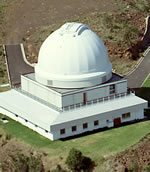
Image credit: RAVE
Researchers from 11 countries are working together to measure the motion and composition of 50 million stars in the Milky Way. This new survey is called RAVE (Radial Velocity Experiment), and astronomers will be able to use the data gathered to construct a very detailed history of our galaxy. They will be able to determine which widely separated stars were formed at a single location, and help answer competing theories about how our galaxy formed. The pilot phase of the project will begin with the UK Schmidt telescope which can measure 600 stars a night, and then production will pick up as other observatories join the hunt.
Clues to how galaxies formed in the early Universe lie right under our nose – in our own Galaxy. The Galaxy formed by the accretion of infalling satellite galaxies, many astronomers think. Theoretical models of the formation of galaxies predict such a scenario. But not all astronomers are convinced yet and the topic is still controversial.
Now researchers from eleven countries have launched an ambitious project to reconstruct our Galaxy’s history by gathering key components of motion and chemi cal compositions for its apparently brightest 50 million stars.
RAVE (RAdial Velocity Experiment) is an all-sky stellar spectroscopy survey just started on the 1.2-m UK Schmidt telescope in eastern Australia.
Projects such as Hipparcos and Tycho have accurately measured the positions and proper motions – movement across the sky – of more than 2.5 million stars.
But to get a complete picture of stellar motions, and thus to enable astronomers to reconstruct the structure and formation history of our Galaxy, they also need radial velocities – the movement of stars towards or away from the observer. And before RAVE began only about 20,000 stellar radial velocities were in the archives.
RAVE will be able to achieve velocities accurate to within 2 km/s – about 1% of the speed at which stars typically move in the Galaxy.
“With this accuracy and this number of radial velocities we will be able to identify dozens, perhaps hundreds, of streams of stars in the solar vicinity. The streams represent debris from disrupted old satellite galaxies now engulfed by our Galaxy,” said Professor Matthias Steinmetz, Director at the Astrophysical Institute Potsdam and leader of the RAVE science team.
Even after plunging into our Galaxy, the stars of a satellite galaxy continue to move as a coherent group, and can be identified by their common velocity even after billions of years. However, only a very few of those disrupted satellites have been identified to date.
RAVE will also gather the chemical compositions of stars. These should help show which widely separated stars were formed at a common site. They should also determine whether these stars have been formed before or after the satellite galaxy of which they were a part broke up.
“RAVE will help us decide between competing models for the formation of the various structures of the Galaxy, such as the central bulge of stars and the so-called ‘thick disk’,” said Steinmetz.
“For a survey such as this, field of view is more important than aperture. The UK Schmidt telescope is a perfect tool for this work,” said Professor Brian Boyle, Director of the Anglo-Australian Observatory, which operates the telescope. The field of view of the UK Schmidt telescope covers an area more than 100 times larger than that of the Moon.
RAVE’s initial pilot phase is being carried out with the 6dF (six-degree field) instrument on the UK Schmidt. Designed and built by the Anglo-Australian Observatory, the 6dF instrument is a ‘pick and place’ robot that positions 150 fibres on the telescope’s focal plane.
Using 6dF, astronomers can collect up to 600 stellar spectra per night. And by 2005 they plan to have 100,000 – five times as many as have been measured since Hermann Carl Vogel started such work at the Astrophysical Observatory Potsdam in 1888.
In 2006 the pace of data collection will pick up even further, when 6dF instrument is replaced by a radical new instrument from the AAO – UKidna, with 2250 fibres mounted on independently movable spines.
“With UKidna we’ll be taking up to 22,000 spectra on a clear night,” said Boyle.
“Then we’ll be able to push beyond our local Galactic neighbourhood, out into the furthest corners of the Milky Way,” said Professor Rosie Wyse of Johns-Hopkins University in Baltimore.
As well as uncovering the history of our Galaxy, RAVE will establish a huge database of stellar spectra – by far the largest to date.
“This will be a vast resource for studies of the properties and evolution of stars,” said Professor Ulisse Munari of the Padova Observatory in Asagio.
With its large database of stellar spectra RAVE will also provide an ideal training set for the design of future space missions such as the European Space Agency’s cornerstone mission GAIA, which will attempt to measure positions and velocities of up to a billion stars in the Milky Way.
Original Source: AIP News Release
Gemini Demonstrates Its Adaptive Optics
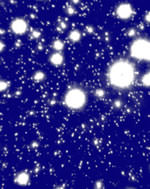
Image credit: Gemini
The latest image taken by the Gemini telescope in Mauna Kea Hawaii demonstrates how powerful its new adaptive optics technology can be. The telescope captured an image of the globular cluster M-13, first with its normal resolution and then using the Altair adaptive optics system; the second image is crystal clear, and contains many more stars which are finely focused. The adaptive optics compensate up to 1000 times a second for distortions caused by the Earth’s atmosphere, so the light appears as if the telescope was in space. This technology is expected to revolutionize ground-based astronomy.
A razor-sharp image was released today revealing new details at the heart of a famous star cluster. The thousands of swarming stars at the cluster’s core were made visible by an innovative adaptive optics system called Altair (after the star Altair) that is currently being commissioned on the Frederick C. Gillett Gemini Telescope on Mauna Kea, Hawai`i.
Among several of the first images from Altair (Altitude Conjugate Adaptive Optics for Infrared), the high-resolution data reveal multitudes of stars with stunning clarity. The dense star cluster known to generations of skywatchers as the Great Hercules Cluster or M-13 is home to hundreds of thousands of stars that, in the center, are often blurred by our atmosphere into a great glowing mass. “The resolution obtained in these images is approximately equivalent to seeing the separation between an automobile’s headlights on the Golden Gate Bridge in San Francisco while standing 3,850 kilometers away in Hawai`i,” said Observatory Adaptive Optics Scientist Dr. Francois Rigaut.
The close-up images of M-13, with and without Altair, as well as a spectacular reference image of the entire cluster, provided by the Canada-France-Hawaii Telescope, can be viewed and downloaded at: http://www.gemini.edu/media/images_2003-2.html.
The remarkable detail in the Gemini images was made possible by Altair’s unique ability to correct starlight that has been blurred by atmospheric turbulence using adaptive optics with altitude conjugation.
Most adaptive optics systems that are currently in use correct for distortions to starlight by assuming that all of the distortions occur where starlight is collected – near the surface of the telescope’s primary mirror. In an altitude-conjugated system like Gemini’s, the distortions are assumed to be at the dominant turbulence layer of the atmosphere. By conjugating or tuning the system for a specific layer above the telescope, Altair can generate a more accurate model of the starlight’s path through our atmosphere.
“Adaptive optics with altitude conjugation is a pioneering new technique that is a powerful way to measure and fix distortions to starlight, which traveled undisturbed for vast distances through space until hitting pockets of warm and cold air in earth’s atmosphere,” said Glen Herriot, the systems engineer who managed the building of Altair in Victoria, BC at the laboratories of the National Research Council of Canada. Altair is able to precisely correct the distorted starlight up to 1,000 times per second using a sophisticated, deformable mirror about the size of the palm of your hand. “The end result is,” says Herriot, “images that rival or even exceed the sharpness of pictures taken from space.”
Working with Gemini Observatory personnel, the Canadian team headed by Project Manager Herriot and Project Scientist Dr. Jean-Pierre V?ran, have been commissioning Altair on Gemini North from late 2002 through early 2003. The instrument team, comprised of 25 scientists and engineers, guided the Gemini adaptive optics system from design to commissioning over the past six years. “Commissioning a precision instrument on a 7-story, 350-ton, sophisticated telescope is especially challenging because of the extremely intricate coordination required to make all the systems work together seamlessly,” said Herriot. Altair’s commissioning on Gemini is expected to be complete before the end of 2003.
A key feature of Altair’s sophistication is the ability to automatically monitor, adjust and optimize multiple parameters during image exposures. The idea is to make adaptive optics user-friendly for our community. When atmospheric conditions allow, simply point and click and near diffraction-limited images are delivered to a camera or spectrograph. Altair continually measures and reports on the images’ level of detail making it one of the most efficient adaptive optics systems in the world. “By routinely delivering infrared images much sharper than is currently possible even from space, Altair gives observers a tremendous advantage in probing deeper in the universe and making more accurate measurements of astronomical objects,” Dr. V?ran says.
“Altair enormously enhances the quality and power of our imaging and spectroscopy,” says Dr. Matt Mountain, Gemini’s Director. “Gemini will soon deliver diffraction-limited images in the near-infrared.” Gemini’s theoretical diffraction limit (maximum resolution) is about 40 milli-arcseconds in the near-infrared H-band (1.6 micrometers wavelength). At this point in commissioning, Altair can deliver 60-milli-arcsecond resolution in the H-band (60 milli-arcseconds is comparable to viewing one grain of sand from about 1.6 kilometers or 1 mile away).
Dr. Mountain pointed out that Altair’s commissioning means that one of the most sophisticated adaptive optics system in the world is now built-in to Gemini North as a facility instrument, and will soon be routinely available to all scientists throughout the Gemini partnership.
“This is a major achievement towards our Gemini goal of delivering space-quality images from an 8-meter, ground-based telescope,” said Dr. Mountain.
Gemini’s Associate Director Dr. Jean-Ren? Roy explains that Altair is a major step forward in Gemini’s aggressive plans to maximize the potential of adaptive optics on ground-based astronomical imaging. Dr. Roy elaborates, “Altair, representing the foundation of tomorrow’s adaptive optics technology, is important for the success of the next generation of 30- to 100-meter, diffraction-limited, infrared, ground-based telescopes now on the drawing boards.”
Future generations of adaptive optics technologies like these will undoubtedly revolutionize ground-based astronomy. For now, Altair is state of the art and provides a powerful new eye on the universe.
Original Source: Gemini News Release
